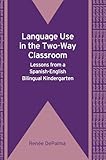Language Use in the Two-Way Classroom : Lessons from a Spanish-English Bilingual Kindergarten / Renée DePalma.
Material type: TextSeries: Bilingual Education & BilingualismPublisher: Bristol ; Blue Ridge Summit : Multilingual Matters, [2010]Copyright date: ©2010Description: 1 online resource (224 p.)Content type:
TextSeries: Bilingual Education & BilingualismPublisher: Bristol ; Blue Ridge Summit : Multilingual Matters, [2010]Copyright date: ©2010Description: 1 online resource (224 p.)Content type: - 9781847693013
- 9781847693020
- 370.117/5 22
- LC3731 .D47 2010
- LC3731 .D47 2010
- online - DeGruyter
| Item type | Current library | Call number | URL | Status | Notes | Barcode | |
|---|---|---|---|---|---|---|---|
 eBook
eBook
|
Biblioteca "Angelicum" Pont. Univ. S.Tommaso d'Aquino Nuvola online | online - DeGruyter (Browse shelf(Opens below)) | Online access | Not for loan (Accesso limitato) | Accesso per gli utenti autorizzati / Access for authorized users | (dgr)9781847693020 |
Browsing Biblioteca "Angelicum" Pont. Univ. S.Tommaso d'Aquino shelves, Shelving location: Nuvola online Close shelf browser (Hides shelf browser)

|

|

|

|

|

|

|
||
| online - DeGruyter European Vernacular Literacy : A Sociolinguistic and Historical Introduction / | online - DeGruyter Ethnographic Fieldwork : A Beginner's Guide / | online - DeGruyter Linguistic Landscape in the City / | online - DeGruyter Language Use in the Two-Way Classroom : Lessons from a Spanish-English Bilingual Kindergarten / | online - DeGruyter ELT, Gender and International Development : Myths of Progress in a Neocolonial World / | online - DeGruyter Illegitimate Practices : Global English Language Education / | online - DeGruyter ATale of Two Schools : Developing Sustainable Early Foreign Language Programs / |
Frontmatter -- Contents -- Chapter 1. The Promise and Realities of Two-Way Instruction -- Chapter 2. The Pragmatics of Two-Way Immersion Instruction: A Closer Look at What Really Happens -- Chapter 3. From Teaching Philosophies to Classroom Design -- Chapter 4. Making Sure They Don’t ‘Give it away’: Keeping Spanish Alive -- Chapter 5. Daily Rituals and Routines: Safety in the Familiar -- Chapter 6. (Spanish) Language Arts: Participating in the Narrative -- Chapter 7. Tables Time: Language in Activity -- Chapter 8. Housekeeping and Blocks Centers: Keeping them Talking -- Chapter 9. Implications: Real Practices behind the Ideal Model -- Appendix: Data coding template -- References
restricted access online access with authorization star
http://purl.org/coar/access_right/c_16ec
Based on an extended ethnographic study of a dual language (Spanish-English) Kindergarten, this book takes a critical look at children's linguistic (and non-linguistic) interactions and the ways that teaching design can help or hinder language development. With a focus on official “Spanish time”, it explores the particular challenges of supporting the minority language use as well as the teacher's strategies for doing so. In bilingual classrooms, teachers' goals include bilingualism as well as academic achievement for all. The children may share these interests, but have their own agendas as well. This book explores the linguistic and social interactions that may help, or hinder, these multiple and sometimes conflicting agendas. How can teachers design educational practice that takes into consideration broader forces of language hegemony as well as children's immediate interests?
Mode of access: Internet via World Wide Web.
In English.
Description based on online resource; title from PDF title page (publisher's Web site, viewed 01. Dez 2022)


